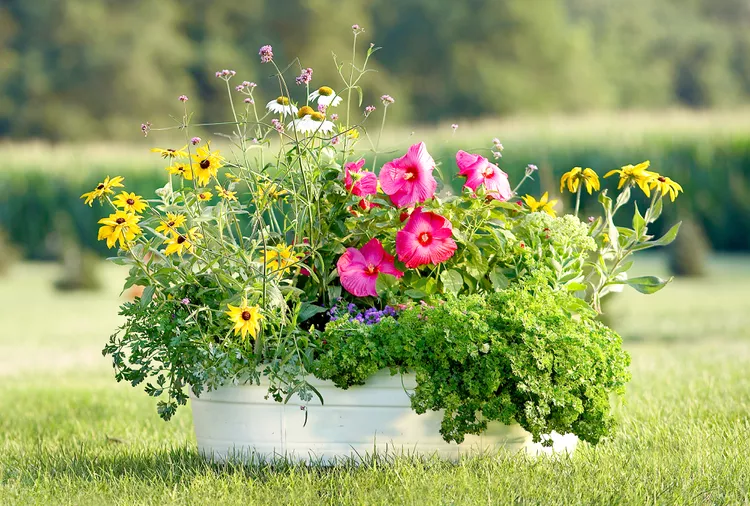Even if you only have a small space, you can almost always find room for a pollinator container garden filled with colorful flowers. Even a balcony pollinator garden is achievable by grouping a few pots to make an expanse of nectar-rich flowers. You just need to choose a container that will accommodate a variety of plants of different heights and habits that will bloom from spring to fall. Then, place the container near a bench or porch where you can watch the pollinators feed and flit around. Here are six must-know tips to help you create a pollinator container garden filled with the best plants for butterflies, hummingbirds, bees, and more.
1. Choose Nectar-Rich Flowers
To create a pollinator container garden that will attract butterflies and bees, you need to include plants with plenty of nectar-rich flowers. The more of these plants you have in your container, the more you'll be able to enjoy butterflies and other fascinating insects. For example, the container above overflows with blue, pink, and red cornflowers along with Spanish lavender, blanket flower, and baby's breath, providing a veritable banquet for pollinators.
2. Focus on Bright Colors
Planting a container with a vibrant mix of red, orange, and bright pink blooms is a sure way to attract hummingbirds as well as butterflies. For ongoing color, consider filling the container with hummingbirds' favorite plants that will offer lots of blooms from spring to fall. Here, 'Mystic Spires' salvia, red and purple verbena, and coral and raspberry autumn sage (Salvia greggii) will lure hummingbirds as well as add a splash of inviting color to the landscape.
3. Pay Attention to Flower Shape
Hummingbirds gravitate toward tubular-shaped flowers. Daisy-shaped flowers help attract butterflies, especially in shades of red, orange, yellow, pink, and purple. The flat flower shape gives the insects a "landing pad" where they can perch while they sip nectar. The container above includes several butterfly favorites such as delphinium, red verbena, and coreopsis, all of which provide nectar as well as ample perches for fluttering wings.
4. Provide Host Plants for Caterpillars
You can help boost butterfly populations by planting "host" plants that will feed caterpillars. Herbs that attract butterflies are magnets for many species of egg-laying females. Here, this repurposed galvanized washtub with drainage holes contains (from right to left) flat-leaf parsley, verbena, white coneflower, hibiscus, sedum, curly parsley, and rudbeckia. In addition the the flowers providing nectar to butterflies and other pollinators, the parsley serves as a host plant for swallowtail butterfly caterpillars.
5. Don't Forget Dill
Dill is another favorite host plant of swallowtails, which are large, beautiful butterflies found throughout much of North America. Simple to start from seed, dill pairs well with salvia, dianthus, and calibrachoa in this container. If you allow dill to flower, it will also attract lots of other beneficial insects such as hoverflies and lacewings, which help to naturally control garden pests.
6. Lean into Diversity
The more variety you can provide in your pollinator container garden, the more successful it will be. Aim to provide a diverse palette of flowers and plants that offer food, shelter, and host sites for all kinds of pollinating insects and other wildlife. Using the largest container you can find, like this repurposed washtub, will allow you to please the most palates. Here, the washtub planter is filled with butterfly bush, rudbeckia, calibrachoa, ageratum, and aster, creating a colorful display that is pleasing to many different pollinators.




















